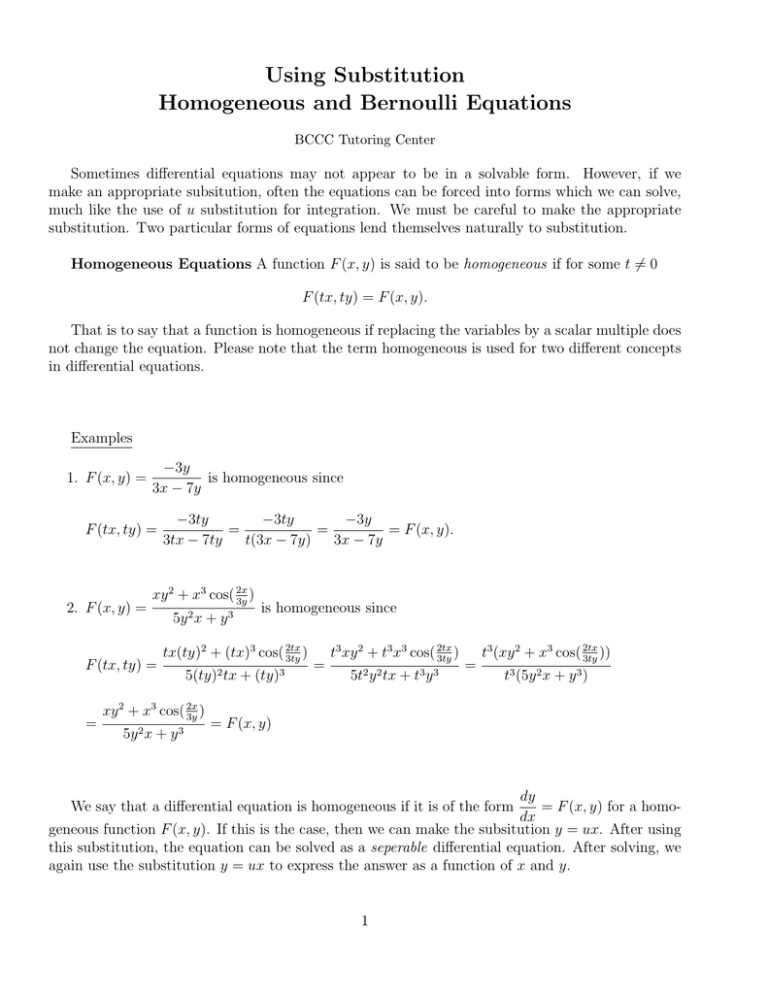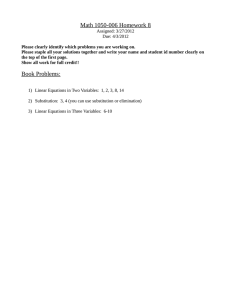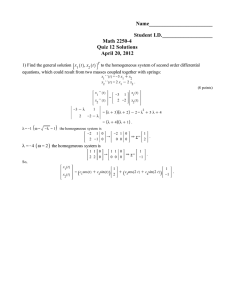Using Substitution Homogeneous and Bernoulli Equations
advertisement

Using Substitution Homogeneous and Bernoulli Equations BCCC Tutoring Center Sometimes differential equations may not appear to be in a solvable form. However, if we make an appropriate subsitution, often the equations can be forced into forms which we can solve, much like the use of u substitution for integration. We must be careful to make the appropriate substitution. Two particular forms of equations lend themselves naturally to substitution. Homogeneous Equations A function F (x, y) is said to be homogeneous if for some t 6= 0 F (tx, ty) = F (x, y). That is to say that a function is homogeneous if replacing the variables by a scalar multiple does not change the equation. Please note that the term homogeneous is used for two different concepts in differential equations. Examples 1. F (x, y) = −3y is homogeneous since 3x − 7y F (tx, ty) = 2. F (x, y) = ) xy 2 + x3 cos( 2x 3y F (tx, ty) = = −3ty −3ty −3y = = = F (x, y). 3tx − 7ty t(3x − 7y) 3x − 7y 5y 2 x + y 3 is homogeneous since ) tx(ty)2 + (tx)3 cos( 2tx 3ty 5(ty)2 tx + (ty)3 xy 2 + x3 cos( 2x ) 3y 5y 2 x + y 3 = ) t3 xy 2 + t3 x3 cos( 2tx 3ty 5t2 y 2 tx + t3 y 3 = t3 (xy 2 + x3 cos( 2tx )) 3ty t3 (5y 2 x + y 3 ) = F (x, y) dy = F (x, y) for a homodx geneous function F (x, y). If this is the case, then we can make the subsitution y = ux. After using this substitution, the equation can be solved as a seperable differential equation. After solving, we again use the substitution y = ux to express the answer as a function of x and y. We say that a differential equation is homogeneous if it is of the form 1 Example 1. dy −3y = dx 3x − 7y We have already seen that the function on the left is homogeneous from the previous examples. As a result, this is a homogeneous differential equation. We will substitute y = ux. By dy the product rule, = x du + u. Making these substitutions we obtain dx dx du −3ux x +u= dx 3x − 7ux Now this equation must be seperated. x −3ux du −3u du −6u + 7u2 du +u= =⇒ x + u = =⇒ x = dx x(3 − 7u) dx 3 − 7u dx 3 − 7u =⇒ 3 − 7u dx du = −6u + 7u2 x Integrating this we get, 1 1 1 − ln(−6u + 7u2 ) = ln(x) + C =⇒ √ = cx =⇒ = cx2 . 2 2 −6u + 7u2 −6u + 7u Finally we use that u = y x to get our implicit solution x2 = cx2 =⇒ −6yx+7y 2 = c. −6yx + 7y 2 Bernoulli Equations We say that a differential equation is a Bernoulli Equation if it takes one of the forms dy dy ym + p(x)y m+1 = q(x) , + p(x)y = q(x)y n . dx dx These differential equations almost match the form required to be linear. By making a substitution, both of these types of equations can be made to be linear. Those of the first type require the substitution v = y m+1 . Those of the second type require the substitution u = y 1−n . Once these substitutions are made, the equation will be linear and may be solved accordingly. 2 Example (a) dy y − = ex y 4 dx 3x You can see that this is a Bernoulli equation of the second form. We make the subdy du stitution u = y 1−4 = y −3 . This gives = −3y −4 . The equation will be easier to dx dx dy y −3 = ex . manipulate if we multiply both sides by y −4 . Our new equation will be y −4 − dx 3x du u Making the appropriate substitutions this becomes −1 − = ex . 3 dx 3x If we multiply by −3 we see that the equation is now linear in u and can be solved: Z du u x + = −3e =⇒ ux = −3xex dx =⇒ ux = −3(xex − ex + C) dx x =⇒ u = −3(ex − ex C + ) x x After undoing the u substitution, we have the solution ex C x 1 x = −3(e − + ) =⇒ y 3 = x 3 y x x e − xex + C 3


